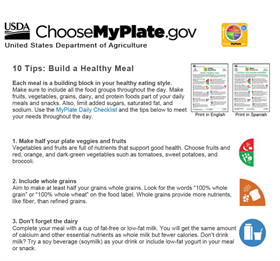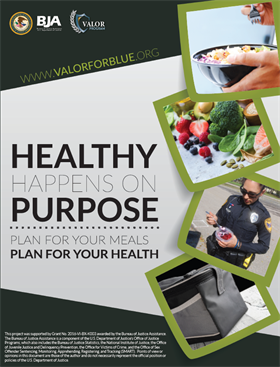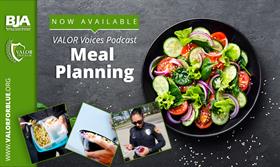.JPG)
Tactical Eating - Simple Meal Planning for Law Enforcement
May 23, 2019
This blog will address something that arguably, we all know is good for us, but that we dread starting or just never get around to: the frightfully simple practice of meal planning. We will look at the basics only (since that’s all you need to get started), specifically, meal planning for lunches at work. First, however, I believe we should start with some of the benefits.
Health Benefits
Most of us who are interested in meal planning want to live healthier lives, gain muscle, and lose fat. While exercise is a critically important part of that equation, it is shockingly ineffective when it comes to losing weight. Generally, a healthy diet makes up a large percent of the successful weight-loss equation. As Shawn Talbot, the former director of the University of Utah Nutrition Clinic, reported, “An analysis of more than 700 weight loss studies found that people see the biggest short-term results when they eat smart. On average, people who dieted without exercising for 15 weeks lost 23 pounds; the exercisers lost only six over about 21 weeks. It’s much easier to cut calories than to burn them off.” (Wexler, 2017).
Let’s look at one of my favorite meals for an example. If you order a bacon cheeseburger (around 920 calories) and fries (around 530 calories), you are consuming around 1,450 calories. “Not to worry,” you think, “I work out regularly, so I’ll burn those calories off with exercise.” A 190-pound person burns 142.5 calories for each mile he or she runs (McDougall, Livestrong). That means if I am going to burn off those 1,450 calories, I will have to RUN more than 10 miles just to break even. You’re not going to burn that off any faster lifting weights, either. To burn off that meal in the weight room, you’re looking at about a 5½-hour lifting session (Langton, Livestrong).
The message here is not that calories are bad or that you need to burn off every calorie you consume through exercise. The message is that a successful weight-management or weight-loss program is highly dependent on calorie intake. From what I have seen and tried over the years, meal planning is one of the easiest and most effective forms of calorie management. There’s nothing wrong with planning and budgeting for a meal out now and then, but when that’s our everyday lunch while on shift, both the calories and expenses quickly add up.
Financial Benefits
Not only is bringing food from home typically healthier and less calorie dense, it’s cheaper. A Visa Survey found that the average lunch out costs $11, while a prepared meal from home costs on average $6.30 (Huang, 2015). The one-year difference in cost between eating out and bringing something prepared from home is $1,715.50. If you invested $1,715.50 a year in a mutual fund, at the end of a 25-year career, you could have around $168,000 (assuming an average annual compounded 10 percent rate of return) (Investor.gov).
Perspective
The first thing to keep in mind about meal planning is that it is personal. We all look at food differently, and what works for one person may not work for someone else. Our family has been doing some form of meal planning for the last 15 years. In those 15 years, our version of meal planning has changed and evolved many times. The best suggestion I can give on meal planning is to start simple. Focus on meal planning your work lunches to start.
Meal Planning
My work lunches have a simple, balanced focus. Each meal has a lean protein source (usually chicken breasts), a carbohydrate source (usually white rice), and a healthy serving of vegetables.
Preparing my lunches for the week in one day is fairly easy. I prefer cooking several lean chicken breasts in the slow cooker or pressure cooker with a jar of salsa or a uniquely flavored sauce from the grocery store (hunt down the lowest in sugar). Literally, this is a two-ingredient recipe—the chicken and the sauce. Throw them in the cooker together, set the timer, and let it cook. I also measure and cook enough rice for the week’s lunches in one large batch. I have found that using a quality rice cooker not only simplifies the process, it makes fantastic rice. The last part is vegetables. I measure out a few bags and boil them on the stove in a large pot.
Once everything is cooked, I use a food scale to measure and divide the food into serving-size bowls that have lids. Because I measure calories and macronutrients, I have a preset amount that goes into each bowl. Don’t stress if you don’t have a food scale—just eyeball the portions to start the habit.
Now each bowl has one serving of chicken, one serving of rice, and one serving of vegetables. I let the bowls cool and then place them in the freezer. Preparing lunch for the next day is now as easy as pulling a bowl out of the freezer and putting it in a bag. I supplement my lunch with protein shakes and bars that I keep in my car just in case I am too busy to stop somewhere and heat up lunch.
Like almost everything else, the most difficult step in meal planning is just getting started. As Goethe said, “Everything is hard before it is easy.” My experience with meal planning has been overwhelmingly positive. I believe this process saves me time and money and significantly contributes to my overall health. Even when I’m tired and craving one of those bacon cheeseburgers, it’s tough to justify buying one when I have a healthy, delicious meal that’s ready to go.
Citations:
Huang, J., “$3,000 for Lunch? Little Splurges Add Up if You’re Not Careful,” USA Today, November 11, 2015, https://www.usatoday.com/story/money/personalfinance/2015/11/11/lunch-saving-budget-dine-out/75170170/.
Investor.gov., “Online Compound Interest Calculator,” https://www.investor.gov/additional-resources/free-financial-planning-tools/compound-interest-calculator.
Langton, N., “Calories Burned in a 30-Minute Strength Exercise Session,” https://www.livestrong.com/article/428523-calories-burned-in-a-30-minute-strength-exercise-session/.
McDougall, A., “How Many Calories Do You Lose Per Mile?,” https://www.livestrong.com/article/314404-how-many-calories-do-you-lose-per-mile/.
Wexler, S., “Exercise vs. Diet: The Truth About Weight Loss,” December 6, 2017, https://www.huffingtonpost.com/2014/04/30/exercise-vs-diet-for-weight-loss_n_5207271.html.
The views and opinions expressed in this blog are those of the authors. They do not reflect the views or opinions of the U.S. Department of Justice.
Recommended Resources
10 Tips: Build a Healthy Meal
This poster provides ten tips for building a healthy meal.
View ResourceHealthy Happens on Purpose
This poster depicts how healthy choices are not an accident. Healthy choices take planning. Law enforcement officers are...
View ResourceMeal Planning
Making healthy meal choices often takes planning, especially when you work the third shift. There are few great choices at...
View ResourceHealthy Relationship With Food
How many of us have gone on a diet and lost weight, only to gain it all back plus a few pounds? What went wrong? Chief John...
View Resource



